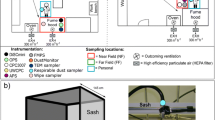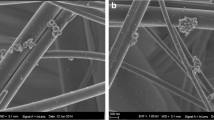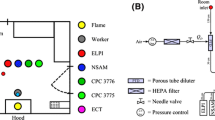Abstract
Manual handling of nanoparticles is a fundamental task of most nanomaterial research; such handling may expose workers to ultrafine or nanoparticles. Recent studies confirm that exposures to ultrafine or nanoparticles produce adverse inflammatory responses in rodent lungs and such particles may translocate to other areas of the body, including the brain. An important method for protecting workers handling nanoparticles from exposure to airborne nanoparticles is the laboratory fume hood. Such hoods rely on the proper face velocity for optimum performance. In addition, several other hood design and operating factors can affect worker exposure. Handling experiments were performed to measure airborne particle concentration while handling nanoparticles in three fume hoods located in different buildings under a range of operating conditions. Nanoalumina and nanosilver were selected to perform handling experiments in the fume hoods. Air samples were also collected on polycarbonate membrane filters and particles were characterized by scanning electron microscopy. Handling tasks included transferring particles from beaker to beaker by spatula and by pouring. Measurement locations were the room background, the researcher’s breathing zone and upstream and downstream from the handling location. Variable factors studied included hood design, transfer method, face velocity/sash location and material types. Airborne particle concentrations measured at breathing zone locations were analyzed to characterize exposure level. Statistics were used to test the correlation between data. The test results found that the handling of dry powders consisting of nano-sized particles inside laboratory fume hoods can result in a significant release of airborne nanoparticles from the fume hood into the laboratory environment and the researcher’s breathing zone. Many variables were found to affect the extent of particle release including hood design, hood operation (sash height, face velocity), work practices, type and quantity of the material being handled, room conditions, and the adequacy of the room exhaust.












Similar content being viewed by others
Notes
CHN is a collaboration among the University of Massachusetts Lowell, Northeastern University and the University of New Hampshire.
Materials were retrieved from manufacturer’s website, http://www.nanophase.com/technology/capabilities.asp (2007).
Materials were retrieved from manufacturer’s website, http://www.ndmaterials.com/silver.php (2007).
References
American Conference of Governmental Industrial Hygienists (ACGIH) (2007) Industrial ventilation, a manual of recommended practice, 26th edn. ACGIH, Cincinnati, pp 13–40
American National Standards Institute (ANSI) and American Industrial Hygiene Association (AIHA) 2003. ANSI/AIHA Laboratory ventilation standard Z9.5. American Industrial Hygiene Association, American National Standards Institute, Inc.
American National Standards Institute (ANSI) and American Society of Heating Refrigeration and Air Conditioning Engineers (ASHRAE) (1995) Method of testing performance of laboratory fume hoods (ANSI/ASHRAE Standard 110–1995). ASHRAE, Atlanta
British Standards Institution (BSI) (1994) Laboratory fume cupboards. Part 4. Method for determination of the containment value of a laboratory fume cupboard (BS 7258: Part 4: 1994). BSI, London
Department of Energy (DOE) Nanoscale Science Research Centers, Approach to Nanomaterial ES&H, Revision2, June 2007, http://www.sc.doe.gov/bes/DOE_NSRC_Approach_to_Nanomaterial_ESH.pdf
Ellenbecker MJ (2007) Interim best practices for working with nanoparticles. Center for High-rate Nanomanufacturing, University of Massachusetts Lowell
European Committee for Standardization (CEN) (2003) Fume upboards-Part 3: type test methods (prEN 14175–3). CEN, Brussels
Flynn MR, Ljungqvist B (1995) A review of wake effects on worker exposure. Ann Occup Hyg 39:211–221
Gerritzen G, Huang L, Killpack K, Mircheva M, Conti J (2006) A review of current practices in the nanotechnology industry, phase two report: survey of current practices in the nanotechnology workplace. International Council on Nanotechnology. http://cohesion.rice.edu/CenterAndInst/ICON/emplibrary/ICONNanotechSurveyFullReduced.pdf
Greenley PL, Billings CE, DiBerardinis LJ, Edwards RW, Barkley WE (2000) Containment testing of laboratory hoods in the as-used condition. Appl Occup Environ Hyg 15:209–216. doi:10.1080/104732200301719
Hemeon W (1963) Plant and process ventilation, 2nd edn. The industrial Press, New York
Hinds WC (1999) Aerosol technology, 2nd edn. Wiley, New York
Huang RF, Wu YD, Chen HD, Chen CC, Chen CW, Chang CP et al (2007) Development and evaluation of an air-curtain fume cabinet with considerations of its aerodynamics. Ann Occup Hyg 51:189–206. doi:10.1093/annhyg/mel051
Kim TH, Flynn MR (1991a) Airflow pattern around a worker in a uniform freestream. Am Ind Hyg Assoc J 52:287–296. doi:10.1080/15298669191364749
Kim TH, Flynn MR (1991b) Modeling a worker’s exposure from a hand-held source in a uniform freestream. Am Ind Hyg Assoc J 52:458–463. doi :10.1202/0002-8894(1991)052≤0458:MAWEFA≥2.0.CO;2
Kim TH, Flynn MR (1992) The effect of contaminant source momentum on a worker’s breathing zone concentration in a uniform freestream. Am Ind Hyg Assoc J 53:757–766. doi :10.1202/0002-8894(1992)053≤0757:TEOCSM≥2.0.CO;2
Pathanjali C, Rahman MM (1996). Study of flow patterns in fume hood enclosures. Proceedings of the 31st intersociety energy conversion engineering conference
Tsai S, Ashter A, Ada E, Mead JL, Barry CF, Ellenbecker MJ (2008) Control of airborne nanoparticles released during compounding of polymer nanocomposites. In press, NANO
Tseng LC, Huang RF, Chen CC, Chang CP (2007) Aerodynamics and performance verifications of test methods for laboratory fume cupboards. Ann Occup Hyg 51:173–187. doi:10.1093/annhyg/mel057
Tseng L, Huang RF, Chen C, Chang C (2006) Correlation between airflow patterns and performance of a laboratory fume hood. J Occup Environ Hyg 3:694–706. doi:10.1080/15459620601015695
Acknowledgment
Authors would like to acknowledge the financial support from the Nanoscale Science and Engineering Centers for High-rate Nanomanufacturing funded by the National Science Foundation (Award No. NSF-0425826).
Author information
Authors and Affiliations
Corresponding author
Rights and permissions
About this article
Cite this article
Tsai, SJ.(., Ada, E., Isaacs, J.A. et al. Airborne nanoparticle exposures associated with the manual handling of nanoalumina and nanosilver in fume hoods. J Nanopart Res 11, 147–161 (2009). https://doi.org/10.1007/s11051-008-9459-z
Received:
Accepted:
Published:
Issue Date:
DOI: https://doi.org/10.1007/s11051-008-9459-z




